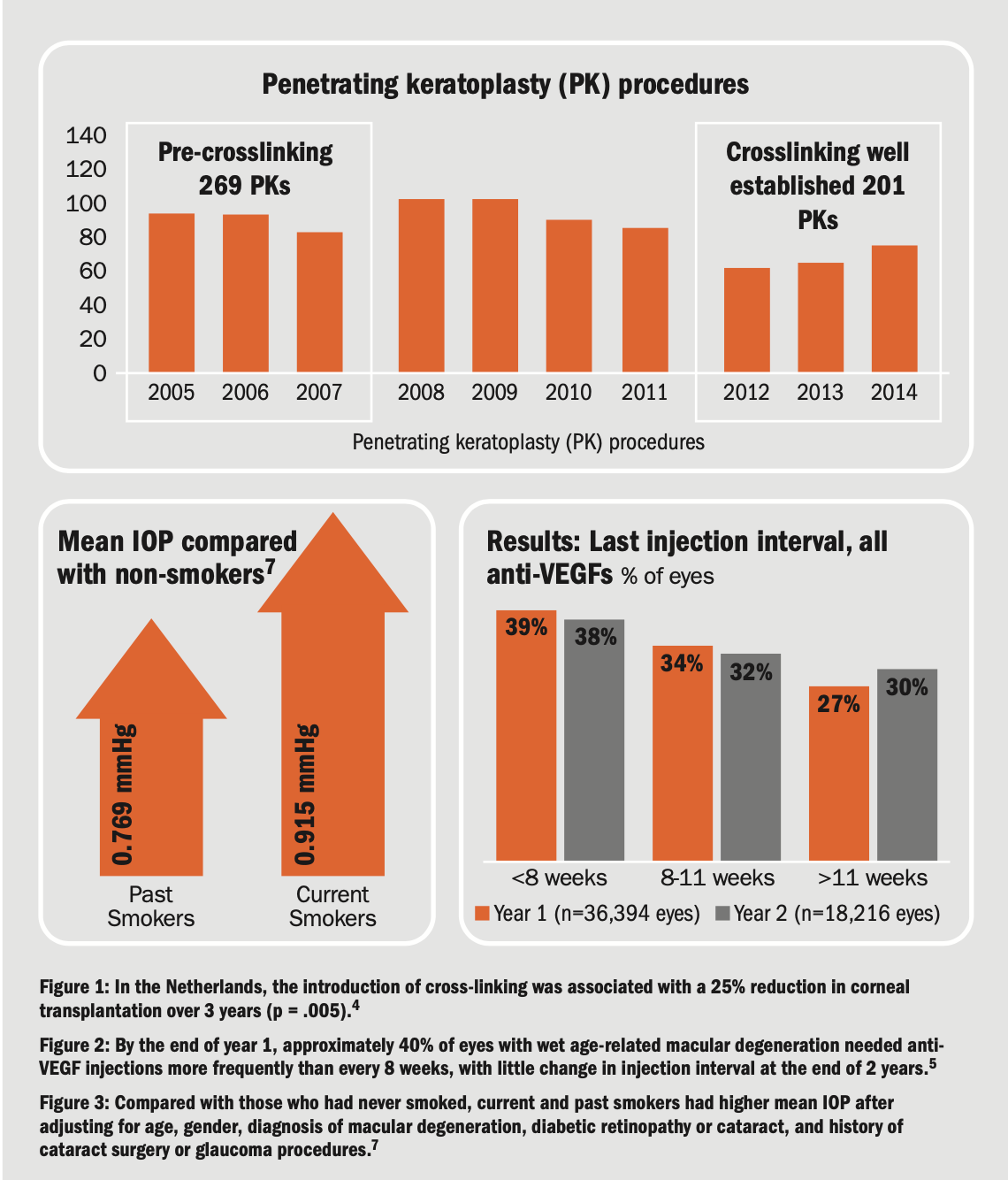Publication
Article
Digital Edition
Big data drives opportunity for real-world evidence
Author(s):
Evidence-based medicine can lead to personalized care, better results for patients

Special to Ophthalmology Times®
The most rigorous data in evidence-based medicine is considered to be that generated by prospective, randomized, controlled trials (RCTs).
RCTs are essential for evaluating the therapeutic impact of a drug or device while eliminating potential confounding factors.
However, there are many situations in which these gold standard clinical trials are not practical or cost effective.
Related: Clinical trial outcomes for macular edema don’t translate to ‘real-world’ settings
RCTs evaluate outcomes for very tightly defined groups of patients with highly standardized care and optimal adherence and follow-up.
In the real world, however, patients present with a variety of underlying systemic conditions, prior surgery, and adherence patterns that muddy the picture. This is where retrospective, observational studies can help to fill the knowledge gap with real-world evidence (RWE).
RWE can help to answer key clinical questions, such as how a treatment works in patients who are already on other medications, and whether switching to or adding a new pharmaceutical agent would be more beneficial.
Real-world studies can demonstrate how a new glaucoma therapy compares with the prostaglandin analogues (PGAs) that most clinicians rely on for first-line therapy, rather than with timolol, the typical control used in FDA studies.
In cardiology, a major ongoing RWE study, the ADAPTABLE trial (NCT02697916), is trying to settle the debate over whether patients with coronary artery disease do better on low- or high-dose aspirin.1
Related: Developing a new therapy: Where do we go from here?
Increasingly, RWE researchers are looking at big data for answers. Very large data registries permit analysis of records from representative patient populations that are orders of magnitude larger than the number of subjects typically found in a phase 3 clinical trial.
Verana Health, through our partnership with the American Academy of Ophthalmology, is actively engaged in curating and analyzing data from the IRIS Registry (Intelligent Research in Sight) to better inform clinical practice in ophthalmology.
The IRIS Registry is the largest specialty clinical database in medicine, with 343 million patient visits and billions of data points reported by more than 15,000 ophthalmologists through their electronic health records (EHR) systems.
Large registries like this offer the opportunity to gather RWE about clinical outcomes. They facilitate research on questions that are critical to patient care but may be less likely to garner industry support such as head-to-head comparisons of new and long-established treatments.
Related: IRIS Registry study: Overall anti-VEGF injection intervals for wet AMD similar at 1, 2 years of treatment
Real-world ophthalmic insights
Large registry studies are relatively new but have already led to changes in ophthalmic practice.
For example, a retrospective analysis of all procedures in the Swedish national cataract registry over a multi-year period revealed that intracameral antibiotics were an important factor in reducing the rate of endophthalmitis.2
This led to a prospective European study of intracameral antibiotics3 and widespread adoption of this method of infection prophylaxis in Europe. A large health maintenance organization (HMO) in the United States also reached similar conclusion about the value of injected antibiotics in cataract surgery after reviewing a large data set from its own EHR system.4
Another national registry helped to establish corneal collagen cross-linking as the standard of care for keratoconus.
Related: Is the time right for crosslinking?
In this case, analysis of healthcare resource utilization in the Netherlands before and after the introduction of crosslinking showed that the procedure was associated with a 25% reduction in corneal transplantation over three years.5
We have been able to use the IRIS Registry data to evaluate real-world anti-VEGF injection intervals in 56,672 treatment-naïve patients with wet age-related macular degeneration.6
In this study, the authors found that the mean number of injections per eye was approximately five per year.
By the end of year 1, approximately 40% of eyes continually treated with anti-VEGF medications needed injections more frequently than every 8 weeks, including 17%-18% who still needed monthly injections.
In another retrospective review of IRIS Registry data for 12.5 million patients seen by an eye care provider in 2017, researchers evaluated the relationship between smoking and IOP.7
After adjusting for many factors, including age and glaucoma diagnosis, smokers (both current and those with a history of smoking) had higher mean IOP than those who had never smoked.
In fact, smoking was the most important predictor of IOP after the glaucoma diagnosis (Figure 3).

Related: IOP homeostasis in glaucoma: Looking below the surface
Challenges of big data
The ability to access large amounts of information to improve medicine is very exciting. But large data sets can be quite challenging to interpret. Imagine a spreadsheet with billions of rows and columns.
No human can realistically check it over for errors; sophisticated algorithms are needed to catch and remove errors in a systematic way. The raw data must be cleaned, harmonized, and structured in such a way that it can be used for clinical research.
To better understand this, consider something as simple as visual acuity (VA)—an important outcome measure in ophthalmic studies.
Data comes into the IRIS Registry every day from thousands of doctors using more than 50 different EHR platforms, each of which collects VA in slightly different fields or formats.
Related: Apps now online to aid patients with visual impairment
VA may have been measured using a Snellen or ETDRS (Early Treatment Diabetic Retinopathy Study) chart, autorefraction, or a pinhole test. The patient may have been tested with or without correction, monocularly or binocularly.
All of that VA data needs to be harmonized so that “20/20” has the same meaning across millions of records.
At Verana, we are using machine-learning techniques to refine algorithms that characterize important information from “unstructured” data, such as free text and images.
Imaging is very important in ophthalmology, so the ability to develop algorithms that can mine images for precalculated measurements such as retinal nerve fiber layer thickness, as well as pathological features (eg, drusen) is highly relevant for future research.
Future directions
In fact, real-world data from large registries opens up many new avenues for clinical research and the advancement of medicine.
The sheer volume of patients offers a chance to drill down into specific subgroups that are underrepresented in clinical trials and to better understand how a disease process or treatment response might vary by gender, race or ethnicity.
We are also passionate about the opportunity to use RWE from the IRIS Registry and other large registries to develop more personalized patient care.
Related: Pearls to educate patients about ocular telemedicine options
Currently, a new glaucoma patient is typically treated first with a prostaglandin analog—the best available treatment, based on the literature.
But what if we had a robust algorithm that could take into account not just the basic diagnosis, but age, ethnicity, gender, and comorbidities, to identify the best treatment paradigm for that individual patient? Ironically, big data has the power to change how we approach small, daily decisions.
And as large as these registries are, there are opportunities to deepen them further through data linking. If we link records from pharmacy prescription databases or serum testing laboratories to the IRIS Registry data, we could get a much clearer picture of diabetic patients’ glycemic control, and potentially be able to evaluate how glycated hemoglobin levels or metformin usage correlate with diabetic retinopathy changes.
We now have the ability to access large volumes of real-world data from very broad patient populations. The possibilities for using that data to improve patient care and drive scientific insights are limitless.
About the authors
Matthew Roe, MD, MHS
e:matthew.roe@veranahealth.com
Roe is chief medical officer of Verana Health. A cardiologist by training, he spent 20 years at Duke University and as an investigator at the Duke Clinical Research Institute in Durham, North Carolina, where he focused on research initiatives leveraging real-world data. He was a principal investigator in the ADAPTABLE trial.
Theodore Leng, MD, MS
e:tedleng@stanford.edu
Leng is a practicing retinal specialist, assistant professor of ophthalmology and director of Clinical and Translational Research at Stanford University Medical School in Stanford, California. He has a research background in image analysis, machine learning algorithms, and clinical trial design and execution. He serves as a medical adviser to Verana Health.
----
References
Johnston A, Jones WS, Hernandez AF. The ADAPTABLE trial and aspirin dosing in secondary prevention for patients with coronary artery disease. Curr Cardiol Rep. 2016;18(8):81. doi:10.1007/s11886-016-0749-2
Friling E, Lundström M, Stenevi U, Montan P. Six-year incidence of endophthalmitis after cataract surgery: Swedish national study. J Cataract Refract Surg. 2013;39(1):15-21. doi:10.1016/j.jcrs.2012.10.037
Endophthalmitis Study Group, European Society of Cataract and Refractive Surgeons. Prophylaxis of postoperative endophthalmitis following cataract surgery: results of the ESCRS multicenter study and identification of risk factors. J Cataract Refract Surg. 2007;33(6):978-988. doi:10.1016/j.jcrs.2007.02.032
Herrington LJ, Shorstein NH, Paschal JR, et al. Comparative effectiveness of antibiotic prophylaxis in cataract surgery. Ophthalmology. 2016;123(2):287-294. doi:10.1016/j.ophtha.2015.08.039
Godefrooij DA, Gans R, Imhof SM, Wisse RP. Nationwide reduction in the number of corneal transplantations for keratoconus following the implementation of cross-linking. Acta Ophthalmol. 2016;94(7):675-678. doi:10.1111/aos.13095
MacCumber M, Yu, JS, Sagkriotis A, et al. Injection intervals in treatment-naïve neovascular AMD patients who received anti-VEGF agents: an analysis of the IRIS Registry. Paper presented at: American Academy of Ophthalmology Annual Meeting October 12-15, 2019; San Francisco. 2019: PO471.
Lee CS, Owen JP, Yanagihara RT, et al. Smoking is associated with higher intraocular pressure regardless of glaucoma. Ophthalmol Glaucoma. 2020;3(4)253-261. doi: 10.1016/j.ogla.2020.03.008

Newsletter
Don’t miss out—get Ophthalmology Times updates on the latest clinical advancements and expert interviews, straight to your inbox.




